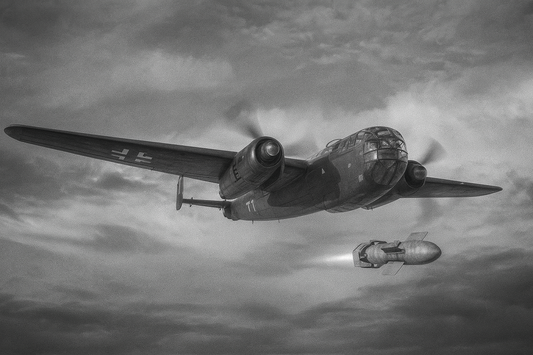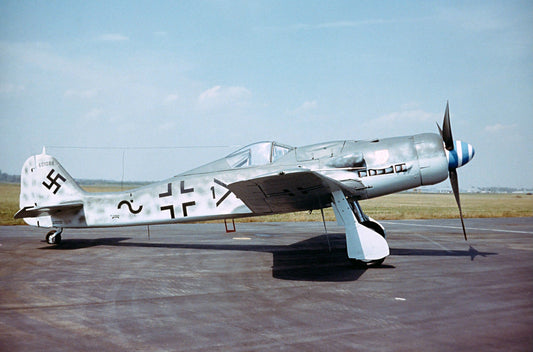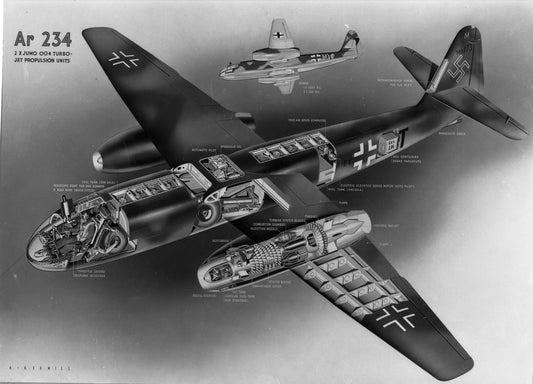Blog
Our blog offers concise, engaging articles on the history of military aircraft—from early designs to modern innovations. Discover how aviation shaped combat and evolved into a key force in global defense.
Blog
Fritz X: Germany’s Pioneering Anti‑Ship Guided Bomb and the Aircraft That Carried It
Germany’s Fritz X was one of the earliest precision‑guided bombs. Weighing about 1.5 tons and carrying a 320 kg armour‑piercing warhead, it was controlled via radio signals from the launch aircraft. Modified Dornier Do 217K‑2 bombers – and a few He 177s – carried the weapon, which had to be dropped from high altitude and kept in view by the bombardier. After unsuccessful trials over Sicily in July 1943, Fritz X made history on September 9 when German bombers sank the Italian battleship Roma and damaged her sister ship Italia. Over the next week, the bomb crippled the US cruiser Savannah, severely damaged the British cruiser Uganda and battleship Warspite, and threatened other Allied ships at Salerno. Allied jamming and air cover soon neutralized the threat, but Fritz X proved that smart weapons could change naval warfare and set the stage for modern guided munitions.
The Carrier Based de Havilland Sea Mosquito: An Ambitious Evolution of the Wooden Wonder
The de Havilland Sea Mosquito was a naval adaptation of the iconic de Havilland Mosquito, one of World War II’s most versatile and innovative aircraft. Dubbed the “Wooden Wonder” due to its primarily wooden construction, the Mosquito had already demonstrated remarkable capabilities in various roles, including reconnaissance, fighter-bomber, and night fighter duties. The Royal Navy sought to capitalize on these attributes by developing a carrier based version, leading to the creation of the Sea Mosquito TR.33 and TR.37 variants.
Origins and Development
The idea of a navalized Mosquito was first explored in 1943, as the Royal Navy sought a twin-engine strike aircraft capable of operating from aircraft carriers. The Mosquito’s high speed, long range, and heavy payload capacity made it an attractive option. However, adapting a land-based wooden aircraft for carrier operations presented significant engineering challenges.
To make the Mosquito suitable for carrier deployment, de Havilland introduced several modifications:
Strengthened airframe and undercarriage: The fuselage was reinforced to withstand the stresses of carrier landings, and a more robust undercarriage was installed.
Arrestor hook: A vital feature for carrier landings, the arrestor hook enabled the Sea Mosquito to engage the ship’s arrestor wires upon landing.
Folding wings: To facilitate storage aboard aircraft carriers, the Sea Mosquito’s wings were designed to fold—a feature not present in the land-based variants.
Navalized engines: The Rolls-Royce Merlin engines were adapted to tolerate the harsher, saltwater-heavy maritime environment.
By 1944, the first prototype, designated Sea Mosquito TR.33, took to the skies. Testing continued throughout 1945, with trials demonstrating the feasibility of carrier operations. The aircraft made its first carrier landing on HMS Indefatigable in March 1944.
Operational Role and Performance
The Sea Mosquito was designed primarily as a torpedo strike aircraft, capable of carrying the 18-inch Mark XV torpedo for anti-shipping operations. In addition to its torpedo-carrying capability, it could be armed with rockets, bombs, and cannons, making it a highly versatile attack aircraft.
Performance-wise, the Sea Mosquito retained much of its land-based counterpart’s speed and maneuverability. It had a top speed of approximately 370 mph (595 km/h) and a combat radius of around 1,300 miles (2,100 km), making it one of the fastest and longest-range aircraft in naval service at the time.
However, the aircraft’s wooden construction, while advantageous in terms of weight and radar visibility, remained a concern in a harsh maritime environment. Extended exposure to salty air and moisture posed risks of structural degradation, limiting the long-term viability of wooden aircraft for naval operations.
Challenges and Limited Adoption
Despite its promising performance, the Sea Mosquito faced several obstacles that ultimately curtailed its operational deployment:
Late War Development: By the time the Sea Mosquito was ready for service, the war in Europe had ended, and the Pacific conflict was nearing its conclusion. The reduced demand for new aircraft limited its adoption.
Carrier Suitability Issues: While modifications allowed for carrier operations, the Mosquito’s large size and twin-engine configuration made it challenging to operate from smaller British aircraft carriers.
Transition to Jet Aircraft: The post-war period saw rapid advances in jet propulsion, leading to a shift away from piston-engine strike aircraft like the Sea Mosquito.
As a result, the Royal Navy opted not to adopt the Sea Mosquito in large numbers. Only a small batch of TR.33 and TR.37 variants were produced, and they were quickly phased out in favor of newer aircraft.
Legacy of the Sea Mosquito
Although the Sea Mosquito never saw widespread operational use, its development demonstrated the feasibility of adapting high-performance land-based aircraft for naval service. The lessons learned from this program influenced future carrier aircraft designs, including twin-engine maritime strike platforms.
Furthermore, the success of the land-based Mosquito remains an enduring testament to de Havilland’s engineering ingenuity. The concept of a fast, multi-role strike aircraft continued to shape military aviation in the post-war era, influencing designs like the de Havilland Sea Hornet and later jet-powered naval aircraft.
Today, the Sea Mosquito is remembered as a fascinating “what-if” in aviation history—a bold but ultimately transitional experiment that bridged the gap between World War II’s piston-engine fighters and the jet age that followed.
Conclusion
The de Havilland Sea Mosquito was an ambitious attempt to merge the advantages of the land-based Mosquito with the requirements of naval aviation. While it faced significant hurdles in its adaptation to carrier-based operations, it showcased the Mosquito’s versatility and underscored the Royal Navy’s evolving approach to aerial warfare. Though it never reached full-scale service, the Sea Mosquito remains an intriguing chapter in the history of naval aviation, representing both the ingenuity and the limitations of carrier-based wooden aircraft in the face of a rapidly advancing technological landscape.
The Focke-Wulf Fw 190D-9: Germany’s "Long-Nose" Fighter of World War II
IntroductionThe Focke-Wulf Fw 190D-9, often referred to as the "Dora" or "Long-Nose Dora," stands out as one of the most formidable fighter aircraft of the German Luftwaffe during World War II. Developed as an advanced variant of the highly successful Fw 190 series, the D-9 was designed to address the shortcomings of earlier radial-engine versions at high altitudes. With its distinctive elongated nose housing a powerful inline engine, the Fw 190D-9 combined speed, agility, and firepower, making it a respected adversary in the skies over Europe.
Development and Design EvolutionThe Fw 190 series, designed by Kurt Tank, initially featured a robust BMW 801 radial engine, which provided excellent low-to-medium altitude performance. However, as the war progressed and Allied bombers operated at higher altitudes, the Luftwaffe required an interceptor capable of matching this challenge. This need led to the development of the "Dora" series, which incorporated a liquid-cooled Junkers Jumo 213 inline engine.
The integration of the Jumo 213A engine necessitated significant airframe modifications. The elongated nose, which earned the aircraft its "Long-Nose" nickname, was required to accommodate the new powerplant and its associated systems. To maintain the aircraft's center of gravity, the fuselage was lengthened by inserting an additional section aft of the cockpit. The tail assembly was also modified, adopting a larger vertical stabilizer to improve stability and control at high speeds and altitudes.
Technical Specification
The aircraft is powered by a Junkers Jumo 213A-1 liquid-cooled V12 engine, producing 1,750 horsepower, which can be boosted to 2,240 horsepower with MW 50 water-methanol injection. It reaches a maximum speed of 426 mph (685 km/h) at an altitude of 21,650 feet (6,600 meters) and has a range of 520 miles (835 km). The service ceiling is 39,370 feet (12,000 meters), allowing it to operate effectively at high altitudes. Its armament includes two 13 mm MG 131 machine guns mounted above the engine cowling and two 20 mm MG 151/20 cannons positioned in the wing roots. The aircraft's dimensions are a wingspan of 34 feet 5 inches (10.5 meters), a length of 33 feet 6 inches (10.2 meters), and a height of 11 feet 3 inches (3.43 meters).
Operational HistoryThe Fw 190D-9 entered service in late 1944, with its first operational units being the III./JG 54 "Grünherz" (Green Hearts) fighter wing. The aircraft quickly proved its mettle against both Allied bombers and fighters. Its combination of speed, high-altitude performance, and heavy armament allowed it to intercept and effectively engage the formidable American B-17 Flying Fortresses and B-24 Liberators, as well as to dogfight with agile Allied fighters like the P-51 Mustang and the Spitfire Mk IX.
One of the most notable operational uses of the Fw 190D-9 was during the defense of the German homeland against the relentless Allied bombing campaigns. It was also heavily involved in the Ardennes Offensive (Battle of the Bulge) in late 1944 and early 1945. The D-9’s performance was so impressive that it was often used in "top cover" roles for the advanced jet-powered Messerschmitt Me 262, providing protection during takeoff and landing phases when the jets were most vulnerable.
FW-190 D9, probably one of the best German fighters of the war, with Leutnant Kurt Tanzer, Staffelkapitän of 13./JG 51, contemplates his final flight from Parchim/Redlin to Flensburg on 2 May 1945 to await the arrival of British forces and surrender.
Pilot Impressions and Combat EffectivenessPilots who flew the Fw 190D-9 generally praised its performance. The aircraft’s powerful engine provided excellent acceleration and climb rates, while its responsive controls made it highly maneuverable. The "Dora" maintained the ruggedness and ease of handling characteristic of the earlier Fw 190 variants, but with enhanced high-altitude capabilities.
In combat, the D-9 proved to be a versatile and deadly opponent. Its armament was sufficient to down heavily armored bombers, and its speed allowed it to engage or disengage from dogfights at will. However, by the time the Fw 190D-9 was introduced, the Luftwaffe was struggling with fuel shortages, experienced pilot attrition, and overwhelming Allied air superiority, limiting the aircraft’s potential impact on the overall air war.
Captured Focke-Wulf Fw 190 D-9 fighters now flying for the Soviet Air Force.
Variants and LegacyWhile the D-9 was the most produced variant of the "Dora" series, other versions such as the Fw 190D-11 and D-13 were developed, featuring improved armament and engines. The D-13, for instance, was equipped with a 30 mm MK 108 cannon firing through the propeller hub, enhancing its bomber-killing capabilities.
Despite its late introduction, the Fw 190D-9 left a significant mark in aviation history. Its design influenced post-war aircraft development, and surviving examples are highly prized by collectors and aviation museums. The "Dora" remains a symbol of German engineering prowess and a testament to the relentless innovation driven by the exigencies of war.
ConclusionThe Focke-Wulf Fw 190D-9 represented the pinnacle of piston-engine fighter development in Nazi Germany. Though it arrived too late to alter the outcome of World War II, its advanced design and impressive performance ensured it a lasting legacy among the legendary aircraft of the conflict. The "Long-Nose Dora" continues to captivate aviation enthusiasts and historians alike, serving as a reminder of the technological advancements and the intense aerial battles of the Second World War.
The Arado Ar 234: The World's First Operational Jet Bomber and Its Legacy
The Arado Ar 234: The World's First Operational Jet Bomber and Its Legacy
The Arado Ar 234, a product of German engineering prowess during the waning years of World War II, holds a distinct place in aviation history as the world's first operational jet-powered bomber. Designed by Arado Flugzeugwerke, the Ar 234 symbolized a significant leap in aerial warfare technology, combining speed, innovative design, and versatility. Despite its limited deployment and minimal impact on the war's outcome, the Ar 234 remains a testament to the technological ambitions and challenges faced by the Luftwaffe in the final stages of the conflict.
Genesis and Development
The conceptualization of the Arado Ar 234 traces back to 1940, when the Reichsluftfahrtministerium (RLM), or German Air Ministry, issued a requirement for a fast reconnaissance aircraft capable of outpacing enemy fighters. Arado Flugzeugwerke responded with a design that would eventually evolve into the Ar 234. Led by chief designer Walter Blume, the development faced numerous hurdles, particularly concerning the jet engines, which were still in their infancy.
The aircraft was initially powered by two Junkers Jumo 004 turbojet engines—the same engines used in the renowned Messerschmitt Me 262 fighter. However, the engines’ unreliability and high fuel consumption posed significant challenges. The Ar 234’s design incorporated a slender fuselage and a high-mounted wing configuration, optimized for speed and altitude. The prototype's maiden flight took place on July 30, 1943, marking the beginning of a new era in military aviation.
Design Innovations and Technical Specifications
The Arado Ar 234 was a marvel of aerodynamic design and technological innovation. One of its most notable features was the use of a tricycle landing gear—an uncommon choice at the time—which improved stability during takeoff and landing. However, early prototypes lacked conventional landing gear and relied on a jettisonable takeoff trolley and retractable skids for landing, complicating ground operations and limiting its operational flexibility.
The aircraft’s streamlined fuselage housed a pressurized cockpit, providing the pilot with enhanced comfort and operational capability at high altitudes. The cockpit was fitted with a glazed nose, offering excellent visibility, and a basic autopilot system to aid in long reconnaissance missions. The Ar 234B, the most produced variant, was equipped with four BMW 003 engines, increasing its speed and range.
Performance-wise, the Ar 234 could achieve a top speed of approximately 742 km/h (461 mph) and an operational ceiling of 10,000 meters (32,800 feet). Its range was around 1,556 kilometers (967 miles), depending on the payload and fuel configuration. The bomber variant could carry up to 1,500 kilograms (3,300 pounds) of bombs, typically in an external fuselage-mounted configuration.
Operational History
The Arado Ar 234's operational debut occurred in late 1944, primarily in reconnaissance missions over Allied territories. Its superior speed allowed it to evade interception, providing the German High Command with valuable intelligence during a critical phase of the war. The reconnaissance variant, the Ar 234B-1, proved effective in photographing enemy positions and movements, contributing to tactical planning.
As a bomber, the Ar 234B-2 faced mixed results. Its high-speed bombing runs made it difficult for Allied forces to intercept, but its limited bomb load and lack of defensive armament reduced its overall impact. The aircraft participated in several notable missions, including attempts to disrupt the Allied supply lines during the Battle of the Bulge and attacks on the Ludendorff Bridge at Remagen in March 1945. Despite these efforts, the Ar 234’s influence on the broader strategic situation was negligible due to its late introduction and the dwindling resources of the Third Reich.
Challenges and Limitations
The Arado Ar 234’s advanced design was hampered by several critical limitations. The most pressing issue was the unreliability of its jet engines, which suffered from frequent mechanical failures and high fuel consumption. Maintenance demands were exacerbated by the scarcity of spare parts and trained personnel as Germany’s war situation deteriorated.
Furthermore, the aircraft's limited payload capacity and absence of defensive weaponry rendered it vulnerable if intercepted. Although its speed provided a degree of protection, the rapid advancement of Allied jet and propeller-driven aircraft gradually eroded this advantage. Additionally, the complexity of operating the takeoff trolleys and landing skids restricted the Ar 234’s operational flexibility, particularly in forward airfields and improvised runways.
Arado 234C - Quad engine late war variant
Legacy and Influence on Post-War Aviation
While the Arado Ar 234's direct impact on World War II was limited, its legacy in the evolution of military aviation is profound. As the first operational jet bomber, it paved the way for future developments in high-speed, high-altitude bombing techniques. The lessons learned from its design and operational deployment influenced both Allied and Soviet post-war jet bomber programs.
Captured Ar 234s were extensively studied by Allied engineers and aviation experts, contributing to the advancement of jet technology in the post-war period. The insights gained from the Ar 234’s performance and engineering were instrumental in the development of subsequent jet-powered reconnaissance and bomber aircraft during the Cold War.
In conclusion, the Arado Ar 234 remains a symbol of both the technological ambitions and the desperate measures of Nazi Germany during World War II. Its innovative design and groundbreaking use of jet propulsion mark it as a milestone in aviation history, despite its operational shortcomings and limited wartime success. The Ar 234's legacy endures as a testament to the rapid advancements in aerospace engineering during one of history's most tumultuous periods.



